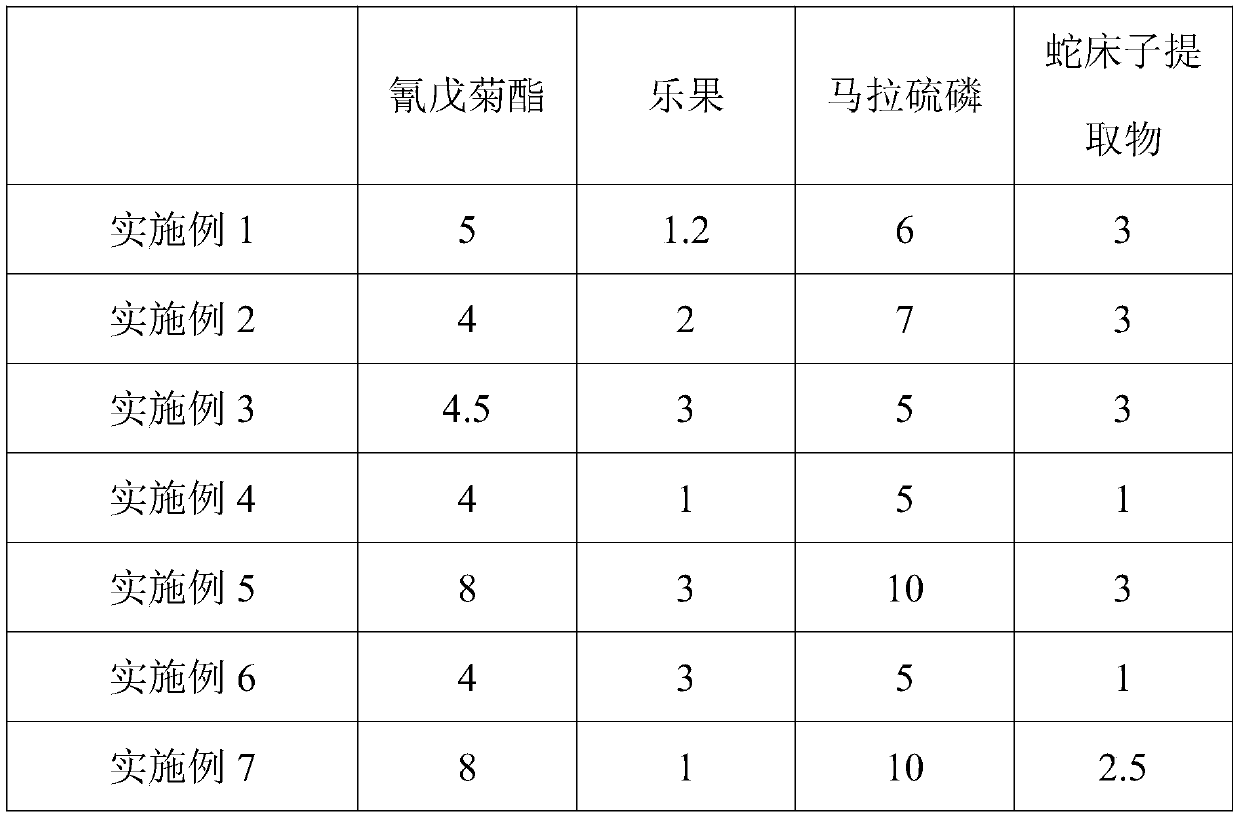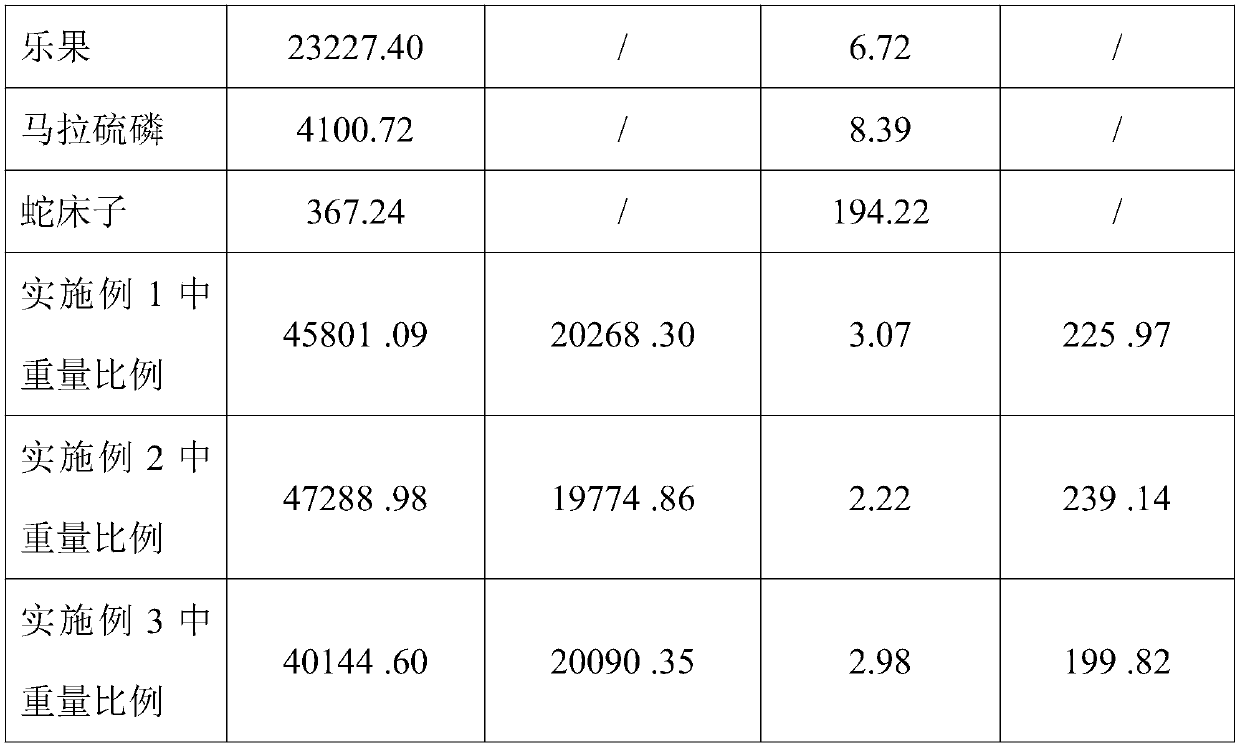Pesticide preventing and curing green tea tree leaf cicada pests
A technology for leaves and green tea, applied in the field of pesticides for preventing and controlling green tea leaf cicada pests, can solve the problems of affecting the yield and quality of green tea, unsatisfactory killing effect, consumption of nutrients and water, etc., so as to prevent the occurrence of green tea tree diseases, slow down the The probability of drug resistance and the effect of reducing the dosage of active ingredients
- Summary
- Abstract
- Description
- Claims
- Application Information
AI Technical Summary
Problems solved by technology
Method used
Image
Examples
Embodiment 1
[0022] A pesticide for preventing and controlling green tea tree leafhopper pests, which is composed of the following raw materials in weight percentage: 5% fenvalerate, 1.2% dimethoate, 6% malathion, 3% Cnidium chinensis extract, and 10% pesticide emulsifier 0201B , sodium tridecyl sulfosuccinate 0.1%, tert-butyl anisole 0.05%, succinate sulfonated hydrogenated castor oil 0.15%, saponin powder 0.02%, azone and octamethyltrisiloxane press The mass ratio is 1:3 composed of 0.3% synergist, 20% ethanol, and water as the balance.
[0023] Its preparation method is as follows:
[0024] First, add the extract of Cnidium Fructus into water and dissolve it with proper ultrasonic heating and shaking for use. Add fenvalerate, dimethoate, malathion, and pesticide emulsifier 0201B into ethanol and stir evenly at high speed, and then mix the above Cnidium Fructus Extract The solution is added dropwise, and after the drop is completed, add tridecyl alcohol sulfosuccinate sodium, tert-butyl...
Embodiment 2
[0026] A pesticide for preventing and controlling green tea tree leafhopper pests, which is composed of the following raw materials in weight percentage: 4% fenvalerate, 2% dimethoate, 7% malathion, 3% Cnidium chinensis extract, pesticide emulsifier 0203B 12 %, sodium ditridecyl sulfosuccinate 0.4%, tert-butylanisole 0.05%, succinate sulfonated hydrogenated castor oil 0.25%, saponin powder 0.02%, azone and octamethyltrisiloxane 1% synergist, 14% xylene, and water as the balance in a mass ratio of 1:4.
[0027] Its preparation method is as follows:
[0028] First add the extract of Cnidium Fructus into water and dissolve it by ultrasonic heating and shaking for later use. Add fenvalerate, dimethoate, malathion and pesticide emulsifier 0203B into xylene and stir evenly at high speed, then extract the Cnidium Fructus The substance solution is added dropwise, and after the dropping is completed, add sodium ditridecyl sulfosuccinate, tert-butyl anisole, succinate sulfonated hydrog...
Embodiment 3
[0030] A pesticide for preventing and controlling green tea tree leafhopper pests, which is composed of the following raw materials in weight percentage: 4.5% fenvalerate, 3% dimethoate, 5% malathion, 3% Cnidium chinensis extract, and pesticide emulsifier 0204 11 %, Ditridecyl sulfosuccinate sodium 0.4%, tert-butyl anisole 0.05%, succinate sulfonated hydrogenated castor oil 0.1%, saponin powder 0.015%, azone and octamethyltrisiloxane 0.4% synergist, 18% cyclohexanone, and water as the balance in a mass ratio of 1:5.
[0031] Its preparation method is as follows:
[0032] First add the extract of Cnidium Fructus into water and dissolve it with proper ultrasonic heating and shaking for later use. Add fenvalerate, dimethoate, malathion, and pesticide emulsifier 0204 into cyclohexanone and stir evenly at high speed, then mix the above Cnidium Fructus Add the extract solution dropwise, and then add sodium ditridecyl sulfosuccinate, tert-butyl anisole, succinate sulfonated hydrogen...
PUM
 Login to View More
Login to View More Abstract
Description
Claims
Application Information
 Login to View More
Login to View More - R&D
- Intellectual Property
- Life Sciences
- Materials
- Tech Scout
- Unparalleled Data Quality
- Higher Quality Content
- 60% Fewer Hallucinations
Browse by: Latest US Patents, China's latest patents, Technical Efficacy Thesaurus, Application Domain, Technology Topic, Popular Technical Reports.
© 2025 PatSnap. All rights reserved.Legal|Privacy policy|Modern Slavery Act Transparency Statement|Sitemap|About US| Contact US: help@patsnap.com



